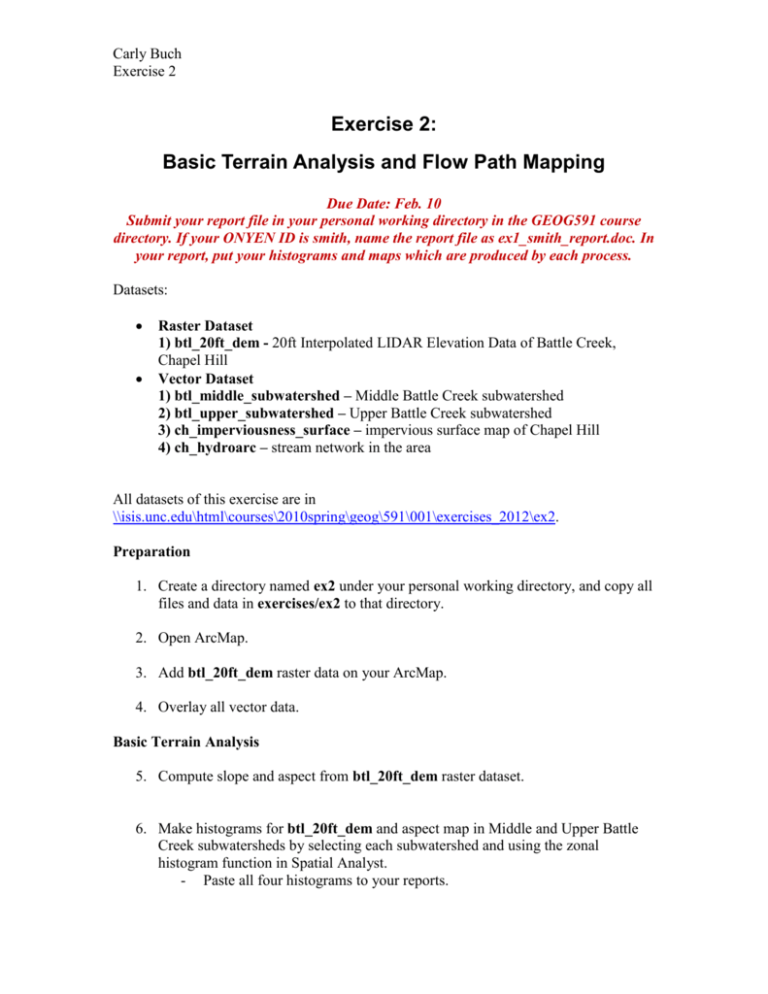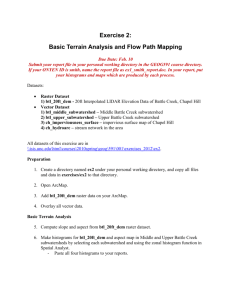cbuchExercise 2_grad.. - The University of North Carolina at Chapel
advertisement

Carly Buch Exercise 2 Exercise 2: Basic Terrain Analysis and Flow Path Mapping Due Date: Feb. 10 Submit your report file in your personal working directory in the GEOG591 course directory. If your ONYEN ID is smith, name the report file as ex1_smith_report.doc. In your report, put your histograms and maps which are produced by each process. Datasets: Raster Dataset 1) btl_20ft_dem - 20ft Interpolated LIDAR Elevation Data of Battle Creek, Chapel Hill Vector Dataset 1) btl_middle_subwatershed – Middle Battle Creek subwatershed 2) btl_upper_subwatershed – Upper Battle Creek subwatershed 3) ch_imperviousness_surface – impervious surface map of Chapel Hill 4) ch_hydroarc – stream network in the area All datasets of this exercise are in \\isis.unc.edu\html\courses\2010spring\geog\591\001\exercises_2012\ex2. Preparation 1. Create a directory named ex2 under your personal working directory, and copy all files and data in exercises/ex2 to that directory. 2. Open ArcMap. 3. Add btl_20ft_dem raster data on your ArcMap. 4. Overlay all vector data. Basic Terrain Analysis 5. Compute slope and aspect from btl_20ft_dem raster dataset. 6. Make histograms for btl_20ft_dem and aspect map in Middle and Upper Battle Creek subwatersheds by selecting each subwatershed and using the zonal histogram function in Spatial Analyst. - Paste all four histograms to your reports. Carly Buch Exercise 2 Upper Slope Histogram: \html\courses\2010spring\geog\591\001\students\cbuch\ex2\slope_btl in zones of J:\html\courses\2010spring\geog\591\001\students\cbuch\ex2\btl_upp VALUE 0.009495846 2.514910642 4.602756305 6.690601968 8.987232197 11.28386243 13.58049266 16.08590746 19.11328367 - 3,500 3,000 2,500 2,000 2.514910641 4.602756304 6.690601967 8.987232196 11.28386242 13.58049265 16.08590745 19.11328366 26.62952805 1,500 1,000 500 0 SUBBA_1268 Upper Aspect: Histograms of D:\ArcGIS\Default.gdb\Aspect_btl_21 in zones of J:\html\courses\2010spring\geog\591\001\students\cbuch\ex2\btl_upper_subwatershe VALUE Flat (-1) North (0-22.5) Northeast (22.5-67.5) East (67.5-112.5) Southeast (112.5-157.5) South (157.5-202.5) Southw est (202.5-247.5) West (247.5-292.5) Northw est (292.5-337.5) North (337.5-360) 2,800 2,600 2,400 2,200 2,000 1,800 1,600 1,400 1,200 1,000 800 600 400 200 0 SUBBA_1268 Middle Slope: Carly Buch Exercise 2 html\courses\2010spring\geog\591\001\students\cbuch\ex2\slope_btl in zones of J:\html\courses\2010spring\geog\591\001\students\cbuch\ex2\btl_mid VALUE 0.009495846 2.514910642 4.602756305 6.690601968 8.987232197 11.28386243 13.58049266 16.08590746 19.11328367 - 2,400 2,200 2,000 1,800 1,600 1,400 1,200 1,000 2.514910641 4.602756304 6.690601967 8.987232196 11.28386242 13.58049265 16.08590745 19.11328366 26.62952805 800 600 400 200 0 SUBBA_1233 Middle Aspect: Histograms of D:\ArcGIS\Default.gdb\Aspect_btl_21 in zones of J:\html\courses\2010spring\geog\591\001\students\cbuch\ex2\btl_middle_subwatersh 3,000 2,800 2,600 2,400 2,200 2,000 1,800 1,600 1,400 1,200 1,000 800 600 400 200 0 VALUE Flat (-1) North (0-22.5) Northeast (22.5-67.5) East (67.5-112.5) Southeast (112.5-157.5) South (157.5-202.5) Southw est (202.5-247.5) West (247.5-292.5) Northw est (292.5-337.5) North (337.5-360) SUBBA_1233 Q1. Differentiate between terrain characteristics in each of the subwatershed areas based on the DEM and aspect distributions. How are DEM and aspect distributed in each of the two subwatersheds? The upper watershed has much more very low slopes than the middle watershed. This is shown by the large amounts of green bars for the upper. This is logical though because Chapel Hill has fairly low grade slopes over the entire region. Chapel Hill is relatively flat as part of the piedmont region of North Carolina. This region is characterized by broad flat areas. The middle watershed though has about equal amounts of low slopes and high slopes. This region must be characterized by gradual slopes whereas it would make sense for the upper region to be characterized by low lying valleys based on the graph of the slope. The most common aspect for the upper watershed is Northeast. The following most common are East, Southeast, and South about evenly. The lowest ones are Southwest and West. For the middle watershed, the most common was southeast. Followed pretty evenly by Northeast, East, and South facing surfaces. These trends are similar to those of the upper watershed. Carly Buch Exercise 2 According to the DEM histogram, the Upper Battle Creek subwatershed has generally higher elevation than the Middle Battle Creek subwatershed (-2.0). Flow Direction Map 7. Make a D8 flow direction map - Go to ArcToolbox Spatial Analyst Tools Hydrology Flow Direction - Name your results as “FlowDir_btl” Flow Accumulation Map 8. Make a D8 flow specific catchment area map Carly Buch Exercise 2 - Go to ArcToolbox Spatial Analyst Tools Hydrology Flow Accumulation Name your results as “FlowAcc_btl” Stream Network Map with threshold 1000 Carly Buch Exercise 2 9. Derive a finite stream network with an accumulation threshold in raster calculator - Go to Spatial Analyst Map Algebra Raster Calculator - Double click “FlowAcc_btl”, “ >”, and type 1000. - Hit “Evaluate”. You can get binary stream network map, which is temporary file with name “Calculation” - Make this file permanent; right click “Calculation” file Data Make Permanent Name it as “stream_1000” Carly Buch Exercise 2 Filling Pits 10. Fill pits - Go to ArcToolbox Spatial Analyst Tools Hydrology Fill - Name your result as “fill_dem_20ft.” Carly Buch Exercise 2 11. Redo all processes from 7 to 9 with the pit-filled DEM (fill_dem_20ft). Name flow direction output with filled DEM as “FlowDir_fill”, flow accumulation output as “FlowAcc_fill” and stream network with threshold 1000 as “str_1000_fill.” Carly Buch Exercise 2 Carly Buch Exercise 2 Note: Make sure that you are using different raster output names for this process (e.g. fill_FlowDir). 12. Repeat the identification of stream channels with a threshold of 500. Name your defined stream network with threshold 1000 as “str_500_fill.” Carly Buch Exercise 2 Q2. Compare the stream network and flow direction maps between the original and filled DEM. What is the major difference between them? No connectivity or organized for a stream network map of the original DEM (-2.0). Carly Buch Exercise 2 The flow direction is very similar for the original and filled DEM, except where pits exist (-1.0). These maps look very similar. This could be because the fill was not extremely large so that the streams were deep enough to not be filled completely in. (see maps below) Original Stream network Carly Buch Exercise 2 Log based 10 of original Original Flow Direction Carly Buch Exercise 2 Filled Stream network Log based 10 of filled map Carly Buch Exercise 2 Filled Flow Direction 13. Use the Map Algebra to detect locations of all pits by subtracting the original and pit removed DEM. - Make the temporary result file permanent (like step 9) and name it “pit_loc.” Q3. Comment on the spatial distribution of depression cells. Where can you find major pits? How does filling pits affect the flow paths of this area? Why? To find the pits I used the raster calculator and subtracted the original file from the filled in file. This gave a positive value to any pits by identifying any raised or filled in areas. I then overlaid the impervious surfaces file so the pits could be easily identified. These pits appear to be major waterbodies in the area. Filling in pits affects the flow by makes drainage complete. IF we did not fill the puts we would have incomplete drainage. Pit location: Around a main stream (Battle Creek) and roads (-1.0) Pits near roads: Some culverts may redirect a stream below a road. Bottom of the Middle Battle Creek subwatershed: By filling the pits, some streams were rerouted and became more connected. Note: Overlay vector files given in this exercises to locate the depression cells. Carly Buch Exercise 2 Carly Buch Exercise 2 Q4. How many hectares is the 1000 and the 500 grid cell threshold that defines the stream heads? Use “FlowAcc_fill”, “str_1000_fill” and “str_500_fill” for the comparison. Carly Buch Exercise 2 Circled stream in red: Stream 1000 layer: 1357 It is easy to tell that the 500 layer is more detailed. More branches are shown by this layer so we should set the threshold here to effectively view streams. What about stream_500? (-2.0) Carly Buch Exercise 2 Q5. What range of drainage area (in hectares) appears to define a stream head in this area? Note: The DEM grid resolution that we used for the analysis is 20ft. Calculation: 1357cells x 400 ft2= 542,800 hectares It’s just ft2, not hectares. (-4.0) 1 square foot = 0.000009290304 hectare So, the unit conversion should be 1357cells x 400 * 0.000009290304 = …. (13/25) Feel free to ask any question to Yuri Kim (yuri513@email.unc.edu.)











